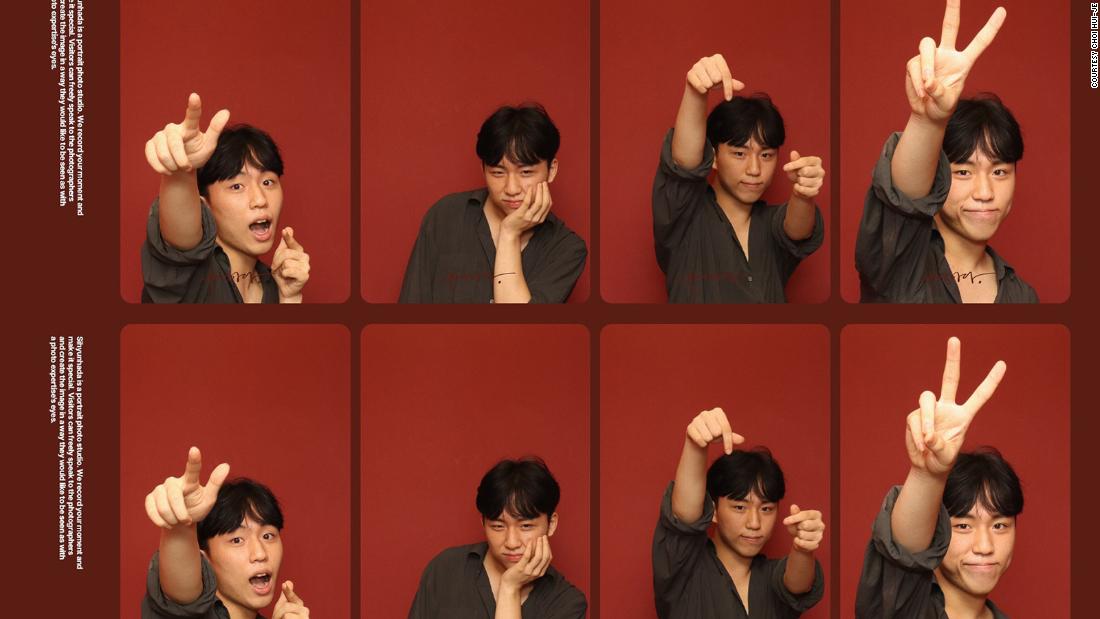A group of girls giggle as they try on a pair of pink glasses, plush pig hats and bunny ears. At another counter of the studio, one carefully straightens her hair. Together, they cram into a photo booth, pose, and then marvel at the photo strips the machine drops below. They tape one onto a wall filled with images of other young patrons.
It’s a familiar scene playing out at several hundred small photo studios that have recently opened in Seoul. The spaces — with no staff visibly present — typically house three to six booths and are open 24 hours a day.
Since the pandemic, the studios have become one of the trendiest destinations among South Korean Gen Z. On the main thoroughfare of Hongdae, the city’s busiest district, they’re found on every block — sometimes, only a few feet apart.
20-year-old university student Choi Hui-je told CNN he visits a studio every time he goes out with friends, which is around five to seven times a month. Once, he recalled in a phone interview, he went five times in one week.
“It’s a necessary stop. We go for food, karaoke, café, and then the photo studio,” Choi said.
19-year-old Jenny Dall’alba, a student in the southern city of Busan, estimates she’s gone more than 70 times over the past few years.
“This is not a fad but a must-go-to every time,” she said.
Many around the world may have their own memories of hopping into similar booths. In the early 2000s, they surged in popularity thanks to the development of digital technology and coveted sticker versions.
But two decades later, in the age of social media and post-pandemic, they’ve taken on a whole new life in South Korea.
Studios differentiate from one another by themes, which is reflected by storefronts, interiors, as well as the appearance of the printed strips themselves. Credit: Charlie Miller/CNN
With over 245 locations in the Seoul Metropolitan area and 200 more around the country, Life4Cuts has a major share of the market: the brand estimates 2 million people visit their studios every month.
On Instagram there are more than 1.1 million posts with the hashtag Life4Cuts (in Korean) — with everyone from K-pop stars to influencers posting the outcome of their shoots.
Some are seen copying poses from viral TikTok videos or mimicking anime characters’ famous moves. Choi himself likes to channel the expressive memes of pink beaver character Zanmang Loopy from the 2003 South Korean animation Pororo the Little Penguin.

A group packs into one of the booths — many are a little more spacious than the ones popular in the early 2000s — to take pictures. Credit: Charlie Miller/CNN
Dall’alba, who keeps all her photos together in a pouch, says she enjoys getting creative by choosing different props and frames. She adds that her friends like to pose with K-pop group members that are baked into each frame and go multiple times to make sure to get a photo with every star.
There are also Instagram accounts dedicated to teaching visitors poses to try the next time in a studio.
Booths nowadays have better lighting and features like timelapses which have contributed to their popularity.

K-pop stars and cartoon characters are regular features on frames. Often, booths provide QR codes so visitors can also download a digital version of their pics. Credit: Charlie Miller/CNN
Business owners see the studios as a safe investment opportunity.
Kim Joo-hyun opened his Busan-based Life4Cuts studio in 2020, when his restaurant began struggling during the pandemic. With no government permit required to operate, he was able to set up a shop in less than a month, with a relatively moderate investment of 180 million won ($134,000).
“There is a widespread notion that you won’t lose money opening them,” Kim said over the phone, adding that it doesn’t take much physical work and he’s seen a profit margin of 50%. And while Kim is concerned with growing competition, he is also actively searching for another location to open a studio.

Each shop offers customers walls of props like exaggerated plush hats and even hair straighteners. Credit: Charlie Miller/CNN
Kim was initially skeptical of whether the studios would be a passing fad, but as people started bringing their family, older relatives, and even dogs into the booth he’s since changed his mind.
“(Customers) can buy small but guaranteed happiness,” he said, for little money at about 4,000 won or $3 a pop. “The day-to-day life may be difficult but they can enter and exit with a smile on their face.”
The tangible aspect of the photos may be what’s particularly appealing to Gen Z. But Choi says there’s something deeper — the pandemic reminded him and others of how precious life is.
“We know well our youth will not last. It’s to remember the precious moments.”
Sumber: www.cnn.com






